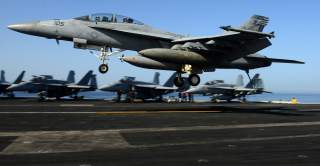The Navy Never Got Its Dream Weapon: Stealth Bombers Flying from Aircraft Carriers
So what happenned?
The Navy’s carrier air wings would have greatly benefited from an A-12-like capability had the program survived.
During the closing stages of the Cold War, the United States Navy was developing a new long-range stealth bomber that could strike at even the most heavily defended targets from the deck of an aircraft carrier. But the ill-fated program was cancelled; leaving a gap in naval aviation capability that has not been filled to this day.
(This first appeared earlier in the year.)
Called the McDonnell Douglas/General Dynamics A-12 Avenger II—a product of the Advanced Tactical Aircraft (ATA) program—the new bomber would have replaced the long-serving Grumman A-6E Intruder. However, as the Soviet threat evaporated, then Defense Secretary Dick Cheney cancelled the A-12 program on January 7, 1991, due to massive cost and schedule overruns as well as severe technical problems. But while the stealthy A-12 had its problems, the bomber’s demise led the Navy to today’s problem: A carrier air wing that does not have the range or penetrating strike capability to defeat advanced anti-access/area-denial (A2/AD) capabilities.
While the Lockheed Martin F-35C Joint Strike Fighter will finally bring X-band stealth technology onboard the carrier and the forthcoming MQ-25 Stingray unmanned aerial refueling tanker will help to extend the range of the existing air wing, those aircraft do not make up for the lack of a heavy hitting long-range bomber platform that can strike deep into the heart of enemy territory. Even with the F-35C and MQ-25, the Navy’s carrier air wings would not be able to strike at Chinese targets in the Western Pacific without putting the carrier at considerable risk. Beijing is able to threaten U.S. Navy carriers with anti-ship ballistic missiles such the DF-21D and the DF-26— the later of which has a range of roughly 2000 nautical miles—by forcing those vessels to operate further out at sea.
The Navy had envisioned the need for a carrier-based penetrating strike aircraft with extended ranges during the 1980s given rapidly advancing Soviet capabilities. Indeed, as former Center for a New American Security scholar Jerry Hendrix, a retired naval aviator, noted, the initial requirements for the A-12 called for an aircraft with a 1,700 nautical mile combat radius and an internal payload of 6,000lbs with a radar cross section comparable to the Northrop B-2 Spirit strategic bomber.
Had the A-12 program panned out, the Navy would still have a potent long-range carrier-based penetrating strike capability that would have been superior to anything currently envisioned. However, technical problems and requirements changes—all of which negatively impacted strike capability—whittled the A-12’s unrefueled combat radius down to 1,000 nautical miles and eventually down to 785 nautical miles. Eventually, as technical problems and program snafus mounted—largely due to “criminal” program management—Cheney was forced to cancel the entire program.
Though it was not immediately apparent at the time, with the cancellation of the A-12 program and the retirement of the A-6E, the U.S. Navy gave up its long-range strike capability in favor of an air wing that focused on sortie generation. While that was not a problem in the immediate aftermath of the end of the Cold War, with Russia resurgent and the emergence of China as a great power challenger, it is a serious issue for the viability of the carrier fleet. The Navy’s carrier air wings would have greatly benefited from an A-12-like capability had the program survived.
Recommended: Air War: Stealth F-22 Raptor vs. F-14 Tomcat (That Iran Still Flies)
Recommended: A New Report Reveals Why There Won't Be Any 'New' F-22 Raptors
Recommended: How an ‘Old’ F-15 Might Kill Russia’s New Stealth Fighter
Analysts have proposed solutions such as a long-range stealthy unmanned strike aircraft as a solution to the Navy’s long-range penetrating strike gap, however, there are problems with that solution. Current Pentagon policy prohibits autonomous weapons from making the decision to take a human life on its own volition, which means that human operators have to be in the loop even when the aircraft is deep inside enemy territory. However, adversaries such as Russia and China will attack the vulnerable data-links that control such an unmanned aircraft through electronic attacks, cyber-warfare or a combination of methods. Drones have been hacked before—by insurgents, no less—thus positive control cannot be guaranteed.
Human pilots, however, cannot be hacked and can make on-the-spot judgments to engage or change targets etc. without the need to home phone—so to speak. Thus, a modern incarnation of a manned carrier-based long-range penetrating strike aircraft might be a solution to the Navy’s range problem. Modern materials, sensor and propulsion technology—particularly advanced adaptive-cycle engines that are currently in development—would solve most of the technical challenges that stymied the A-12 program.
Given that advanced adaptive cycle engines which are currently in development promise to reduce fuel burn by more than 35 percent, a new carrier-based bomber should be able to meet a 1100 nautical mile combat radius requirement even given the size constraints of carrier aircraft. Thus, the Navy should consider the development of a next-generation carrier-based long-range penetrating strike aircraft. Like the original ATA, which was also slated to replace the Boeing F-15E, a modern incarnation of such a warplane could also replace the Strike Eagle while supplementing the Boeing F/A-18E/F Super Hornet and F-35C on the carrier flight deck. It will not be cheap, but given that President Donald Trump has signaled his intent to invest heavily in the nation’s defense, it is an option that the Navy should consider.
Dave Majumdar is the former defense editor for The National Interest.


